Live coverage on this blog has ended, click here for latest news on Ida
Hurricane Ida made landfall on the coast of Louisiana Sunday as a powerful Category 4 hurricane, but was downgraded to a tropical storm early Monday. It's the storm's slow movement, sustained power and direction that are of ongoing concern.
Ida has slowed considerably but continues to draw energy from its own storm surge as well as the moisture of the area. The combination is hitting New Orleans with heavy rains in addition to strong winds, overpowering some levees and leaving more than one million people without power throughout Louisiana.
Ida downgraded to tropical storm
The National Hurricane Center has downgraded Ida to a tropical storm.
The center said maximum sustained winds have decreased to near 60 mph, with the storm now over southwestern Mississippi.
Ida made landfall as a Category 4 hurricane Sunday with winds of near 150 mph.
It is expected to continue rapidly weakening during the next day or so, the center added. It's expected to become a tropical depression by Monday evening.
Despite the downgrade, the center warned that dangerous storm surge, damaging winds and flash flooding will continue over portions of southeastern Louisiana and southern Mississippi.
Levee failure in Alliance, Louisiana prompts evacuations
Residents have been urged to evacuate after a levee failure in Alliance, about 20 miles southeast of New Orleans.
Plaquemines Parish government urged people to evacuate the area immediately in a Facebook post late Sunday. Residents were told to go to a local auditorium if they need shelter.
Around the same time, the National Weather Service issued a flash flood emergency warning for the area, warning of a "life-threatening flash flooding from a levee failure."
The warning is in effect until 6:45 a.m. E.T.
Power still out for more than 1 million people in Louisiana
More than one million people remain without power as Hurricane Ida batters Louisiana, according to tracking website poweroutage.us.
Earlier, the entire city of New Orleans lost electricity due to "catastrophic transmission damage," with the city's only power coming from generators.
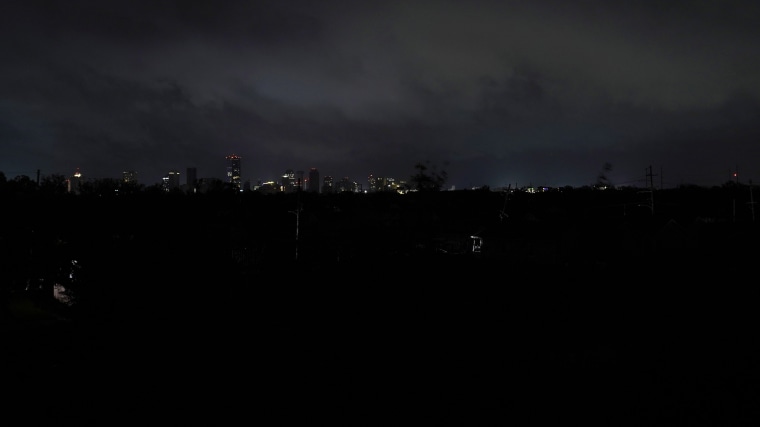
Flash flood emergency warning for Laplace, Luling and Destrehan
The National Weather Service on Monday warned of a flash flood emergency for Laplace, Luling and Destrehan, communities west of New Orleans, Louisiana. Residents were advised to move to higher ground and not walk or drive through flood waters until at least 8:30 a.m. E.T.
'Still a beast': Hurricane Ida remains powerful 13 hours after landfall
'Very, very bad': Images show damage, flooding from Hurricane Ida
As Hurricane Ida made landfall Sunday in southern Louisiana as a devastating Category 4 storm, NBC News compiled videos and photos showing the impact of 150 mph winds and what officials called a "catastrophic" storm surge.
Levee failure poses imminent threat to two communities
The National Weather Service office in New Orleans, citing local law enforcement, said Sunday night that over 200 people were in "imminent danger" in the town of Jean Lafitte and the unincorporated community of Lafitte, in Jefferson Parish, after a levee failed.
"Move to higher ground now!" the weather service said. "This is an extremely dangerous and life-threatening situation."
New Orleans mayor says power plant is compromised
Biden approves disaster declaration for Louisiana
President Joe Biden declared a major disaster exists in Louisiana on Sunday night, freeing federal aid for people and governments in the affected areas.
Residents of these parishes are eligible: Ascension, Assumption, East Baton Rouge, East Feliciana, Iberia, Iberville, Jefferson, Lafourche, Livingston, Orleans, Plaquemines, Pointe Coupee, St. Bernard, St. Charles, St. Helena, St. James, St. John the Baptist, St. Martin, St. Mary, St. Tammany, Tangipahoa, Terrebonne, Washington, West Baton Rouge, and West Feliciana.
The aid can be used for temporary housing and home repairs, low-cost loans to cover uninsured property losses, and other programs to help individuals and business owners. Funding assistance for debris removal is also available.
Residents and business owners who suffered losses can begin applying for assistance Monday by registering online or by calling 1-800-621-FEMA(3362) or 1-800-462-7585 (TTY) for the hearing and speech impaired. The toll-free telephone numbers will operate from 7 a.m. to 10 p.m. (local time) seven days a week until further notice.
Photo: A mother makes dinner for her child as Ida rages
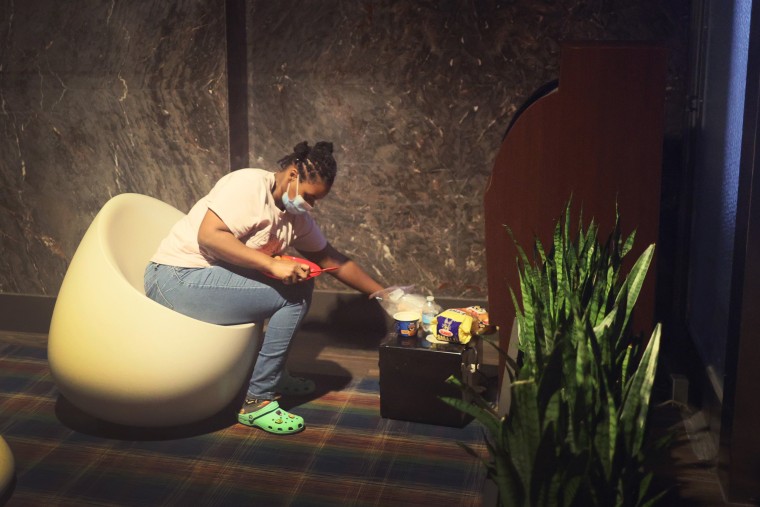
First Hurricane Ida-related death confirmed
The first death attributed to Hurricane Ida was confirmed Sunday evening by officials in Ascension Parish.
The victim was a 60-year-old man who had a tree fall in his home, the Louisiana Department of Health tweeted.
Just after 8:30 p.m., deputies with the Ascension Parish Sheriff's Office received reports of a fallen tree on a home in Prairieville, Louisiana, according to the sheriff's office's Facebook page. When they arrived on the scene, deputies found a deceased victim.
Prairieville is about 66 miles northwest of New Orleans. News of the first fatality comes as the storm causes widespread power outages and flooding.
Gulf Coast hospitals brace for Ida, most near capacity with Covid patients
Photos: Firefighters cut through trees as Ida rages in Louisiana
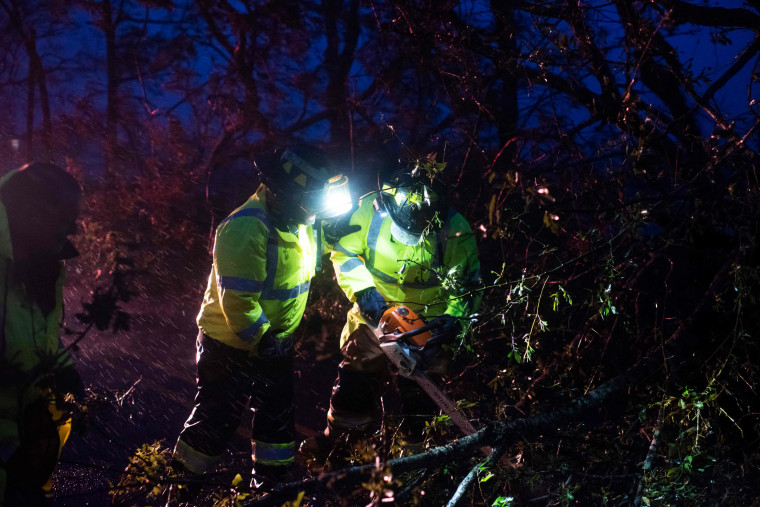
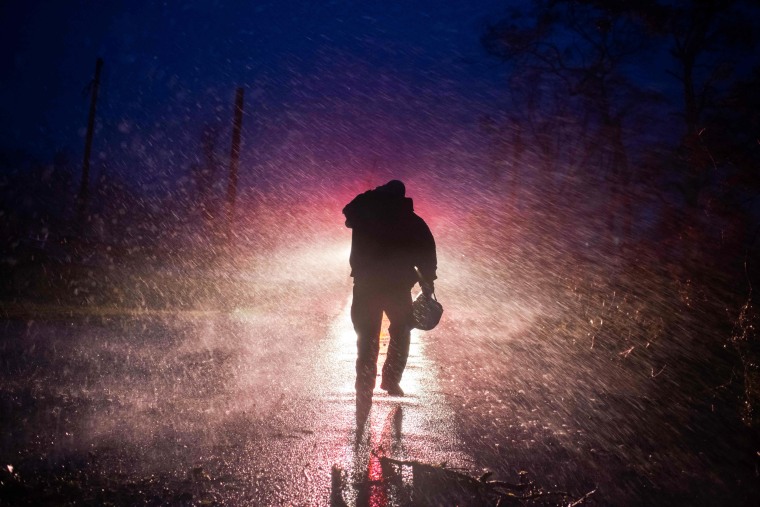
Boil water advisory issued in Jefferson Parish
Residents in a southeastern Louisiana parish were told Sunday to boil their water after Hurricane Ida slammed into the state as a devastating Category 4 storm.
The advisory, from Jefferson Parish, was issued for the area’s East Bank. A loss of pressure in the distribution’s system was to blame, the parish said.
The order came amid widespread power outages across southeastern Louisiana, including the entire city of New Orleans.
All of New Orleans loses power due to 'catastrophic transmission damage'
All of New Orleans has lost power, the city's utility provider said Sunday evening, hours after Hurricane Ida slammed into Louisiana.
In a tweet Sunday at 8:27 p.m. ET, NOLA Ready, the city of New Orleans' emergency preparedness campaign, shared that Entergy New Orleans had confirmed that New Orleans had no electricity, and that the city's only power was coming from generators.
The loss of power was due to "catastrophic transmission damage" from the storm, according to Entergy.
It was not immediately clear how the mass outage was affecting local hospitals.
As Hurricane Ida barreled toward the Gulf Coast, some residents chose to 'stay and pray'
As Hurricane Ida rapidly intensified into a Category 4 storm threatening the Gulf Coast, residents of the area faced a difficult decision — to stay and ride out the storm, or to brave the clogged highways and hastily evacuate.
Ida made landfall in southeast Louisiana early Sunday afternoon with 150 mph sustained winds as authorities warned of "catastrophic" damage that could threaten all homes and people in its path.
Hurricane warnings are all too familiar to Gulf Coast residents who have lived through countless storms, but the severity of this one took some by surprise, leaving little time to prepare.
On Friday evening, Louisiana Gov. John Bel Edwards warned that Hurricane Ida was "changing, it seems, by the hour."
"Now is the time to finish your preparations," Bel Edwards said. "By nightfall tomorrow night, you need to be where you intend to ride out the storm and you need to be postured as you would want to be as the storm approaches you."
Six hours changed New Orleans' preparation
On Friday evening Mayor LaToya Cantrell warned New Orleanians that Hurricane Ida had unexpectedly strengthened and moved “more rapidly than anyone was prepared for.”
It was too late to order an evacuation, she said, or to call for the major interstates to reverse all lanes in the directions out of the city — a tactic called contraflow that leaders in Louisiana use to quickly evacuate populated areas when dealing with a dangerous hurricane or other major emergency.
“Time is not on our side,” she said in that day's second press conference. “The city cannot issue a mandatory evacuation because we don’t have the time.”
While some locals criticized the delayed evacuation order, other storm-seasoned residents as well as scientists defended the mayor and said Hurricane Ida’s speed and power were alarming and difficult to predict.
Hurricane Ida made landfall Sunday in southern Louisiana as a ferocious Category 4 storm, tearing roofs from a hospital and homes, flooding roads and sending ferries adrift.
There were no immediate reports of fatal injuries or estimates of property damage, but officials urged residents to stay put until the storm passed.
Jefferson Parish President Cynthia Lee Sheng told reporters earlier Sunday that the only road into Grand Isle, a barrier island south of New Orleans that is home to less 1,000 people, was under six feet of water. The local fire station was flooded, she said, and a few dozen people appeared to have disregarded a mandatory evacuation order.
“The conditions are very, very bad,” she said. “They are really getting beaten up right now.”
Power outages mount in Louisiana
Ida downgraded to Category 3 storm but risk remains high
Hurricane Ida, which made landfall Sunday as a Category 4 storm, was downgraded around 7:30 p.m. ET to a Category 3.
But the change does not make Ida any less threatening to the Gulf Coast. Any hurricane rated Category 3 or higher is considered a "major" storm, according to the National Hurricane Center.
Category 3 storms generally have sustained winds of 111 to 129 mph, and the damage they cause can be devastating, according to the NHC.
"Well-built framed homes may incur major damage or removal of roof decking and gable ends. Many trees will be snapped or uprooted, blocking numerous roads. Electricity and water will be unavailable for several days to weeks after the storm passes," the NHC said in an explanation of the category on its website.
Louisiana hospital scrambles to keep patients breathing after generator failure
Doctors and nurses at a Louisiana hospital directly in the path of Hurricane Ida were forced to manually pump air into the lungs of patients after a generator failed and the ventilators stopped working in an intensive care unit, the state health department confirmed Sunday night.
The stricken patients were moved to another floor of Thibodaux Regional Health System, said Mindy Faciane, a spokeswoman for the Louisiana Department of Health said.
It wasn’t immediately clear how many patients were being relocated, but State Rep. Jerome Zeringue (R-Houma) told the local newspaper he’d been in touch with a doctor who reported the generator failure and who described the situation as “Katrinaesque.”
Two dozen Louisiana hospitals had to be evacuated during Hurricane Katrina after they lost power, water and sewage services.
Christina Stephens, a spokesperson for Gov. John Bel Edwards, said the facility “had not lost all critical power.” She said some patients were moved to another part of the facility and the state health department was working with the hospital.
Gov. Edwards requests a major disaster declaration
Louisiana Gov. John Bel Edwards requested a presidential major disaster declaration on Sunday evening as Hurricane Ida ravaged the state, according to a release put out by the governor's office.
The release cited the thousands of people in Louisiana without power following the storm's impact as well as storm surge and winds, which were still thrashing parts of the state Sunday evening and expected to impact areas farther inland into Monday.
“Hurricane Ida is one of the strongest storms to ever hit Louisiana ... This major disaster declaration will help Louisiana better respond to this crisis and protect the health and safety of our people, and I hope the White House will act quickly so we can begin getting additional aid and assistance to our people,” Edwards said.
President Joe Biden had already granted a federal declaration of emergency prior to the storm's arrival, but the major disaster declaration will allow the state to access additional assistance.
The request includes individual assistance as well as critical needs assistance for parishes dealing with the worst of the storm's impact. The governor's office anticipates there will be many residents who are displaced for an extended period of time due to the storm. Edwards has also asked for help with debris removal and repairing infrastructure damage.
Ida is going strong and slow. That's bad news.
It’s been six hours since landfall, and Ida remains a Category 4 hurricane with maximum sustained winds of 130 mph.
Despite making landfall, Ida has maintained much of its intensity because of the warm and saturated ground of the marshy wetlands. The storm is feeding off the bayous and behaving as if it’s still over water.
While it hasn’t weakened much, it has slowed down to a crawl and made a turn to the north. This means the eyewall with the core of the strongest winds could edge closer to downtown New Orleans, bringing the risk for 100 mph winds or higher.
With the strongest winds of Ida now threatening the New Orleans metro, meteorologists caution to never evacuate vertically into high rise buildings. Wind increases with height, so the speeds atop a 30-story building, for example, could be an entire category higher.
Ida's current behavior — strong and slow — is not a good combination.
And it’s not just the winds that will roar through the night across southeastern Louisiana but also a high risk for flash flooding. Projections of 6-12 inches of rain, with isolated areas picking up 20-24 inches, can cause deadly urban flooding and river flooding expected to last into the night.
Meteorologists warn about powerful elements of Ida
Meteorologists and other scientists have spotted a particularly dangerous element of Ida: a series of especially violent vortices — or areas of air moving in rotation — that can include high winds.
These circular wind patterns, known was mesovortices, tend to occur close to the storm's eye, making it all the more menacing.
"These distinct eyewall mesovortices (little filaments inside the typically circular eye) of Hurricane Ida are remarkable, and especially dangerous," tweeted Michael Lowry, a strategic planner and atmospheric scientists with the Federal Emergency Management Agency. "Mesovortices are often associated with extreme, tornadic-like winds, one of many reasons you should never venture out during the eye."
Eric Snitil, chief meteorologist of the WROC local TV station in Rochester, New York, tweeted that it's not uncommon for strong storms to have these small vortices circling around the eye.
"Small satellite eddies called mesovortices rotate around the parent circulation, giving almost a starfish shape to it," he wrote. "Not uncommon in particularly strong hurricanes."
Bill Karins, a meteorologist with NBC News, likened the shape created by the mesovortices to a four-leaf clover, though not a particularly lucky one.
Photos: Ida drenches New Orleans after making landfall
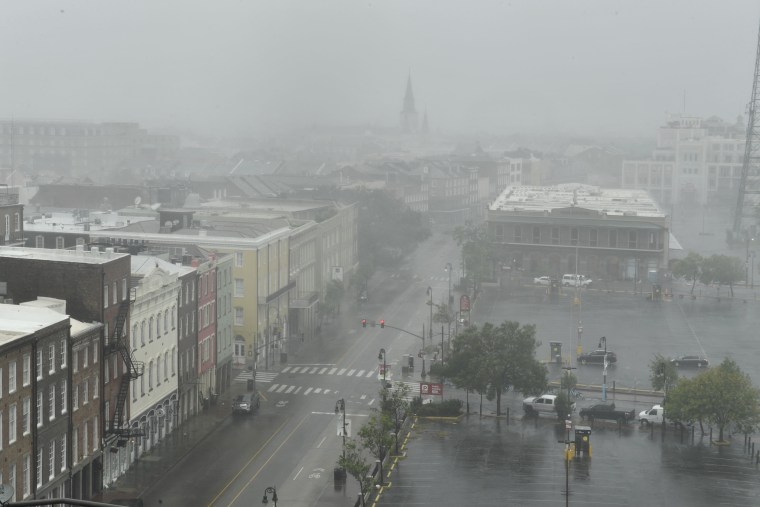
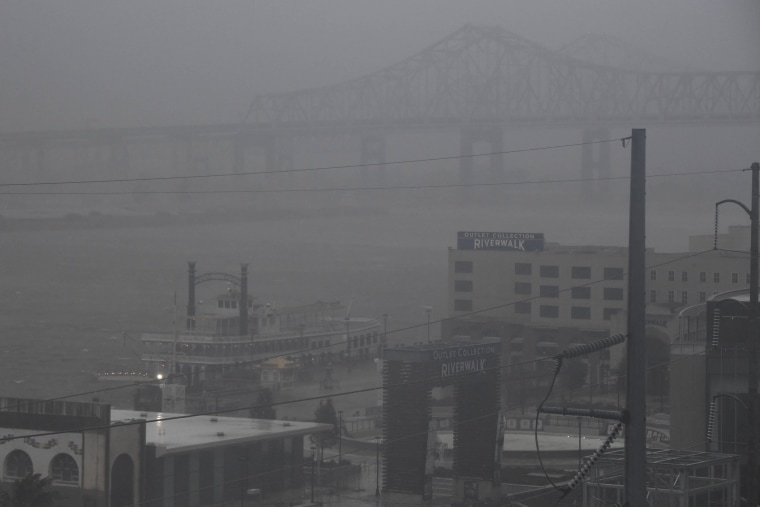
National Weather Service: 'This is not what you want to see.'
In Jackson, Miss., residents fill up sandbags ahead of potential flash floods
JACKSON, Miss. — At a sandbag distribution site in Mississippi’s capital Sunday afternoon, residents scrambled to collect supplies to help fortify their homes ahead of a potential onslaught of flash flooding that could follow heavy rain wrought by Hurricane Ida.
More than a dozen people shared shovels and buckets and hoisted bulky bags into their vehicles underneath an overcast sky as thunder rumbled.
Debra Jones spent about 30 minutes shoveling sand into 12 bags that she planned to place along her front door and garage. Her west Jackson home hasn’t flooded before, but water has seeped into her neighbors’ homes during previous storms.
"I'm hoping and praying everything is going to be well," she said.
The city’s Public Works Department has already announced that the parts of some streets prone to flooding will be closed starting Monday.
Frederick Gates, who helped supervise and direct traffic at Sunday’s distribution, said the Public Works Department was beginning to work off a second pallet of supplies.
The warning that Ida, a Category 4 storm, could bring strong wind and major rain to central Mississippi prompted Jones to stock up on batteries, flashlights and foods that won’t spoil quickly in power outages.
Jones said the storm’s making landfall on the 16th anniversary of Hurricane Katrina evoked a heightened sense of caution.
“This puts a little fear in us to get more prepared,” she said.
Deanna Vail said her home in south Jackson has flooded at least twice — once in 1984 and again last year — in the almost 30 years she has lived here. She borrowed a family member’s truck to haul away about 25 sandbags with the help of her younger brother.
Winds pick up in Houma, Louisiana
Power outages are spreading across New Orleans
'Wind speeds are going crazy'
The winds gusting through Louisiana appear to be ferocious.
In a video uploaded by Twitter user @TerrebonneGavin, fierce and high-powered winds can be seen thrashing trees somewhere in the town of Galliano.
"Oh my God — wow," an unidentified person can be heard saying in the video clip.
Boats appear to collide as Ida bears down
Two boats appeared to collide on the waters off St. Rose, Louisiana, as Hurricane Ida whipped up fierce winds on Sunday afternoon.
The moment was recorded and uploaded to Twitter.
"Oh my God. They're heading for each other," an unidentified person can be heard saying in the video. "You guys, this is unbelievable."
St. Rose sits on the east bank of the Mississippi River.
Fire station's security camera shows fast-rising waters
Time-lapse video from security cameras in a St. Bernard Parish fire station show flood waters rising quickly, inundating the southeastern Louisiana building in less than hour.
The National Weather Service used the video to demonstrate Hurricane Ida's danger.
"This is how fast surge can rise," the agency's New Orleans field office said on Twitter. "You are putting your life in danger if you are in a surge prone area. PLEASE STAY AWAY FROM THE COAST!"
Some staying put in Baton Rouge, Louisiana, as storm hits
NBC News’ Sam Brock reported that businesses, hotels and apartment buildings throughout downtown Baton Rouge, Louisiana, hadn't been boarded up as the city awaited the storm.
Standing before a fleet of trucks that will be deployed to restore customers’ power when the hurricane is gone, Brock said he found people “hanging out” by the Mississippi River as Ida was barreling toward the city.
Brock said he spoke to the Baton Rouge mayor, who said the city has invested some $20 million to try to improve the drainage system and “drain the water that could cause trouble” in the aftermath of the storm.
He also spoke to one couple who said they planned to stay put because they had parents in their 80s and jobs in the area.
"I definitely think there's plenty of homes that will be affected by this," the woman said. "We are fortunate that we are on very high ground, I think ours will be OK, but we might be helping all of our neighbors."
Photo: Ida causes severe damage in New Orleans' French Quarter
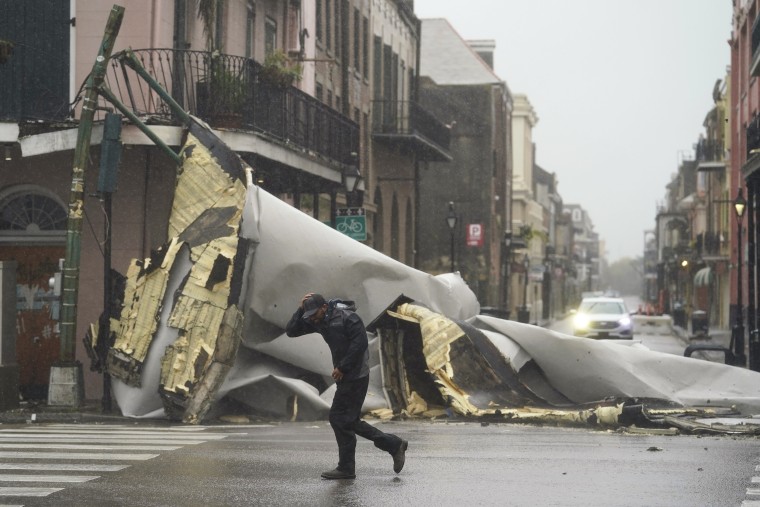
Louisiana Gov. John Bel Edwards says state has "never been more prepared" for hurricane
Louisiana Gov. John Bel Edwards reassured his constituents during a press conference on Sunday afternoon that the state was prepared to take on the forces of Hurricane Ida as the storm raged.
"There is no doubt that the coming days and weeks are going to be extremely difficult for our state … but as a state we’ve never been more prepared," Edwards said.
Edwards said the state had 900 people as part of the search and rescue efforts, split among 21 teams standing by during the storm and its aftermath.
Out of the state's 692 floodgates, 459 had been closed, Edwards said, and although officials reaffirmed their confidence in the levees, which have been improved since Hurricane Katrina hit 16 years ago, Edwards said the state was expecting "overtopping" on some of the levees.
"Will it be tested? Yes," Edwards said of the flood protection system. "But It was built for this moment."
He also urged residents not to panic about overtopping.
"Overtopping and levee failure are not the same thing," he said. "Obviously we will continue to monitor our flood protection systems."
Edwards warned that people may need to prepare shelter in place for up to 72 hours after the storm. While he implored people to stay home, he said if people needed to go out and got stuck, that it could be a while for help to arrive.
He added that parishes would be deciding on and announcing curfews for their respective residents.
Those who evacuated need to check with their local officials before returning, Edwards said.
He said that 1,542 people were currently being sheltered across the state.
Biden visits FEMA headquarters: 'Planning for the worst'
President Joe Biden visited the headquarters of the Federal Emergency Management Agency (FEMA) in Washington Sunday to receive a briefing on Hurricane Ida, shortly after the massive storm made landfall in Louisiana.
Biden's visit, which had not been previously announced, came as he returned from Dover Air Force Base to witness a "dignified transfer" event for U.S. service members killed in Thursday's terror attack in Kabul.
FEMA says it has deployed more than 2,400 employees to the states along the Gulf Coast, including search and rescue and ambulance teams, along with 2.5 million meals, 3.1 million liters of water, 76,000 tarps and 64 electric generators.
"We're praying for the best, and planning for the worst," Biden said in brief remarks at the agency. "We're going to put the country's full might behind the recovery."
When he finished, the president said he was "not supposed to take any questions, but go ahead." When a reporter asked a question about Afghanistan, though, he cut her off and said, “I’m not going to answer on Afghanistan."
Officials say they are 'confident' that levees in southeast Louisiana will hold
Officials said Sunday that levees are "stronger" and "higher" in southeast Louisiana now than they were 16 years ago during Hurricane Katrina, and that they are confident the state's infrastructure will hold during Hurricane Ida.
"We are much better protected that we were during Katrina," Regional Director of the Southeast Louisiana Flood Protection Authority Kelli Chandler said in an interview with MSNBC's Alex Witt.
More than $14 billion has been spent improving the state's flood defense system, Chandler said.
"We feel very strongly confident that the system will perform as designed," she said. "We may have some local street flooding and we will have supplies for power outages. We've already started experiencing that."
Just before 3 p.m. ET, electric utility Entergy New Orleans reported that nearly 300,000 customers were without power in New Orleans.
"This is a very intense storm. It's a very unique storm ... but we're confident in the performance of the system," Chandler said.
Power outages top 212,000 in New Orleans
More than 212,000 customers are without power in New Orleans as Hurricane Ida pummels Louisiana.
Entergy New Orleans, an electric and natural gas utility based in New Orleans, reported the outages as of 2:18 p.m. ET.
The outages have been rising sharply since Hurricane Ida made landfall on Sunday afternoon.
Tulane University moves students out of residence hall near construction crane
Tulane University moved students out of some residence halls that were near a construction crane out of "an abundance of caution," the school's President Michael A. Fitts said in an email to students.
"Students living by Irby, Phelps, Paterson, and Wall residence halls have been relocated to The Commons/LBC complex as a precaution since these residence halls are near the crane tower off McAlister Way," Fitts said in the email. "The crane is built to withstand winds far above what we are expecting but, out of an overabundance of caution, we moved students away from the construction site."
Hurricane Ida made landfall on Sunday afternoon with maximum sustained winds of 150 mph.
Fitts also wrote that, although the storm's path had deviated from what was anticipated, the school had taken precautions and all residence halls had been secured and supplied with back-up emergency power.
Three days worth of food was distributed to on- and off-campus students ahead of the hurricane, Fitts said. Those who felt unsafe off campus were given shelter on campus, the email stated.
"We are fully staffed at the Hyatt and Jung hotels for students who are in isolation there and they are being provided with meals," the email read.
More than 145,500 customers without power in New Orleans
Entergy New Orleans reported that more than 145,500 customers are without power shortly after Hurricane Ida made landfall in Louisiana. That number appears to be rising.
During a press conference Sunday afternoon, New Orleans Mayor LaToya Cantrell acknowledged the widespread power outages but urged residents to stay home.
The update from Entergy New Orleans, an electric and natural gas utility and former mass transit provider that was based in New Orleans, Louisiana, was posted at 1:40 p.m. ET.
Photo: Residents travel on a jet ski as Ida storm surge floods Mississippi town
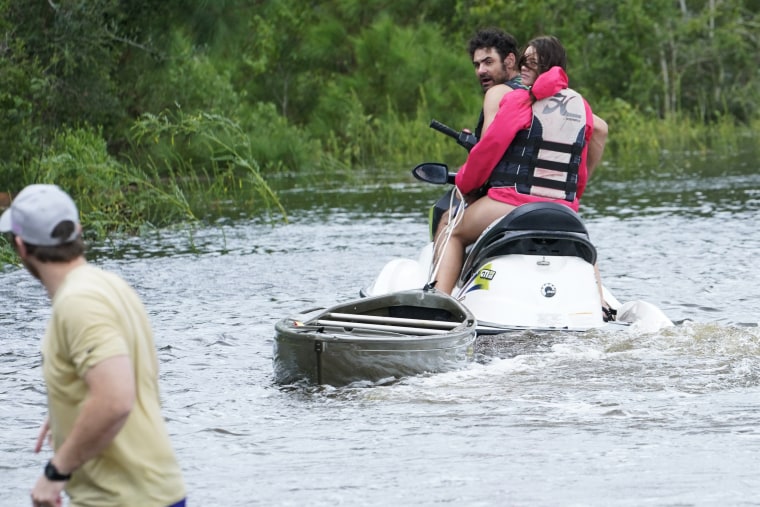
'There’s nobody coming right now': New Orleans mayor, other officials warn residents to stay home
During a press conference Sunday afternoon, New Orleans Mayor LaToya Cantrell told residents that now is the time to hunker down and stay home just ahead of Hurricane Ida's landfall just before noon local time.
"You are not to come out until you receive more information from the city of New Orleans," Cantrell said during a press conference on Sunday afternoon. "Now is the time that we have been preparing for and even waiting for as it relates to Hurricane Ida."
Collin Arnold, director of the New Orleans Office of Homeland Security and Emergency Preparedness, echoed the mayor, warning residents that emergency services wouldn't be able to reach them until Monday.
"You need to stay inside until tomorrow. We’ll look at this during the first light of day," Arnold said. "There’s nobody coming right now. You need to stay inside."
Officials at the news conference warned that residents who didn't evacuate but had changed their mind Sunday afternoon would be out of luck, and that they should not call the police.
"As Ida moves closer we will see sustained winds of 75 mph. These are life-threatening winds. You absolutely need to remain indoors," Arnold said.
Cantrell also urged residents to conserve water as the storm moved in and acknowledged that some residents had begun losing power.
Officials also noted that the city is in a different place than it was 16 years ago when Hurricane Katrina tore through New Orleans, noting that $14 billion had been invested in the levee system. The levees are not a concern at this moment, officials said.
"You have everything that you need," Cantrell said. "We will get through this together."
Baton Rouge mayor says residents should shelter in their homes
The mayor of Baton Rouge, Louisiana, said her city is working to get "out front" of Hurricane Ida, with crews and parish officials spending much of the last 72 hours making emergency preparations.
In an interview with NBC News, Sharon Weston Broome advised residents to take shelter in their homes rather than evacuating, but she called on people to "do what they have to do."
"We are not thinking that we will have a consistent deluge that takes place," Broome said. "But nevertheless, it's incumbent upon us to prepare for whatever."
Hurricane Ida has made landfall
Hurricane Ida made landfall near Port Fourchon, Louisiana, around 12:55 p.m. ET Sunday, with maximum sustained winds estimated to be 150 mph, according to the National Hurricane Center.
In an all-caps message at the top of the latest advisory, the hurricane center called Ida, a Category 4 storm, "EXTREMELY DANGEROUS."
Ida was about 15 miles southwest of Grand Isle, Louisiana, and about 45 miles southeast of Houma, Louisiana, according to the NHC.
Electric company warns hard-hit customers could lose power for weeks
Entergy, an energy company that provides electricity to millions of customers in the Deep South, warned Sunday afternoon that Ida could knock out power systems for weeks.
In a statement, the company said customers in the "direct path" of a Category 4 hurricane such as Ida "can experience outages up to three weeks." The statement went on to say that while 90 percent of customers will have their power restored sooner, "customers in the hardest-hit areas should plan for the possibility of experiencing extended power outages."
Entergy insisted it was thoroughly prepared to deal with the aftermath of the storm, with a "workforce of over 7,000 ready ready to restore service." The company added that it anticipated mobilizing a storm team of at least 16,000 workers.
'Just hope for the best'
Mississippi Gulf Coast could see storm surge; emergency declaration approved
JACKSON, Miss. — Almost a third of Mississippi’s counties are now eligible for reimbursement from the federal government for funds spent in preparation for Hurricane Ida, according to a statement on Sunday from the Mississippi Emergency Management Agency.
The approved pre-disaster Emergency Measures declaration covers 24 counties and the state's only federally recognized Native American tribe, the Mississippi Band of Choctaw Indians.
Gov. Tate Reeves warned during a Saturday storm briefing that the Mississippi Gulf Coast could see up to 11 feet of storm surge in some areas. Power outages throughout the state are also expected.
Climbing admissions in recent weeks of patients seriously ill from Covid-19 have overwhelmed hospitals in Mississippi's coastal counties. Health care leaders are bracing for the loss of electricity by stocking up on supplies with emergency generators at the ready.
"Access to care is a national issue, but a hurricane makes it even worse," Randall Cobb, the Singing River Health System's director of facilities and support, said in an interview with Mississippi Today. "Hospitals are at capacity. In our emergency departments, there are multiple-hour wait times."
Three hours north, several school systems in central Mississippi have already canceled classes for Monday. The Jackson Public School District and Madison County Schools will be closed tomorrow.
Zello is popular during disasters. But it doesn't work without cell service, internet
When Hurricane Harvey hit Texas in 2017, people on the ground used Zello — a messaging app that has been compared to a walkie-talkie — to communicate without cell phone numbers. The popularity of Zello in the aftermath of Harvey and other natural disasters has created the perception that the app is a reliable alternative to phone calls or text messages in the event of a power outage.
But as the makers of the app have clarified in the past, Zello does not work without cellular data service or an internet connection on your phone. In other words, people along the Gulf Coast will not be able to use Zello to communicate if Ida knocks out networks, limiting access to cellular data and WiFi.
Zello's official Twitter account has previously attempted to clear up the confusion, writing in 2017 that there was "massive misinformation among users" about the app's capabilities.
"There has been some misinformation about Zello requirements. Please inform others: Zello REQUIRES Internet using either WiFi or cellular data network of at least 2G," Zello tweeted at the time.
Hurricane Ida nears Louisiana coast
The northern eyewall of Hurricane Ida was moving onshore along the coast of southeastern Louisiana with a sustained wind of 89 mph and and a wind gust of 104 mph as of 12 p.m. ET, according to the National Hurricane Center.
The storm was about 25 miles south-southwest of Grand Isle, Louisiana, and about 60 miles southeast of Houma, Louisiana, the NHC said in its latest advisory.
Parish north of New Orleans already reporting power outages and gas shortages
As Hurricane Ida neared the Louisiana coast, local leaders in the parish just north of New Orleans across Lake Pontchartrain said approximately 7,600 homes were already without power and gas shortages had been reported.
St. Tammany Parish President Michael Cooper provided the news in what he expected to be the last live report from the local government until after Hurricane Ida had passed.
“Stay vigilant,” Cooper added. “Call us if you need us. We’re here to serve to the extent that we can.”
Cooper warned of the danger of the hurricane and told local residents that the parish had instituted a curfew that would start at 12 p.m. Central Time. The curfew is expected to continue until “the danger of Hurricane Ida has passed,” he said.
Leaders also warned local residents who were considering last-minute evacuations of the imminent closure of the Lake Pontchartrain Causeway — the longest bridge over water in the world that connects St. Tammany Parish with New Orleans and the key southern highway Interstate 10.
For those who were remaining, Cooper said he was unsure whether the two local shelters — both gymnasiums — were full. Locals, he said, should shelter in place if they can and remain indoors with their families.
Even if the storm reduces in strength, he said, “it is still a dramatic storm and one we have to reckon with.”
Graphic: Storms are packing a rainier punch
Storms are delivering more rain.
Intense rainfall, like the rains Hurricane Ida brings with it, are increasingly becoming a part of hurricane and tropical storm activity, which scientists attribute to climate change.
The National Oceanic and Atmospheric Administration tracks the rainiest point measured of storms affecting the U.S. and Mexico. According to an NBC News analysis of its data, the maximum rainfall per year is up from an average of 11.5 inches of rain per storm in the 1970s to an average of 15.9 inches in the 2010s.
See the per-year averages below.
Biden authorizes 2,000 FEMA employees to respond to Ida
President Biden has approved an emergency disaster declaration ahead of Hurricane Ida making landfall in order to activate federal resources that can assist states most affected by the storm.
The declaration deployed 2,000 FEMA employees to Alabama, Florida, Georgia, Louisiana, Mississippi, and Texas, according to a release from White House Regional Communications Director Ike Hajinazarian. Among those being deployed are seven FEMA incident management teams in Louisiana and Mississippi.
Additionally, FEMA activated 100 ambulances and EMS personnel to assist with post-storm evacuations as well as 13 urban search and rescue teams.
In Alexandria, Louisiana, a FEMA staging area has been set up with food, water and generators, and in Mobile, Alabama, the U.S. Coast Guard has prepared fixed and rotary aircrafts and shallow water boats.
The U.S. Coast Guard has also cleared any barges along the Mississippi coastline as well as New Orleans. Ports in Houma, Louisiana, and New Orleans closed on Saturday.
Three U.S. Departments of Health and Human Services Disaster Medical Assistance teams based in Louisiana, Alabama and Mississippi are also in place for assisting the state's response to the Covid-19 pandemic.
Photo: New Orleans' French Quarter is mostly empty ahead of Ida's arrival
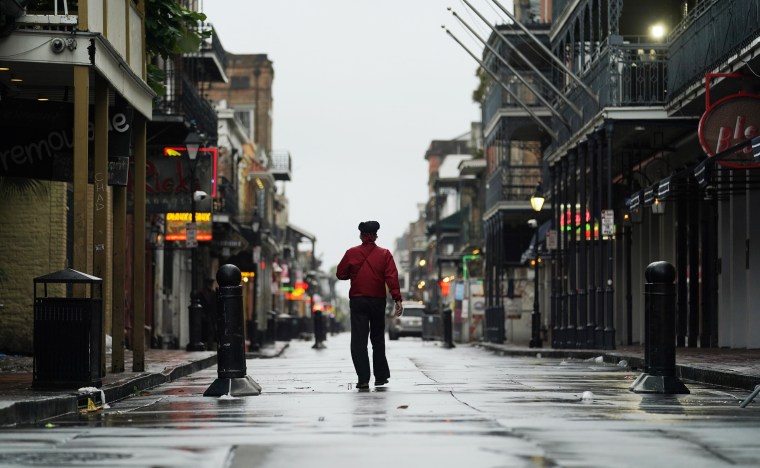
Hurricane categories, wind speeds aren't enough to pinpoint storm's true threat
Hurricane Ida is expected to make landfall as a Category 4 storm. But in the eyes of some leading scientists and researchers, a storm's category doesn't tell you the whole story — and it shouldn't be the only metric used for making important public safety decisions during potentially life-threatening natural disasters like hurricanes.
"We focus so much on the one big number — Category 5, Category 1 — because it's easy and sexy to talk about," Michael Mann, a professor of atmospheric science at Penn State, previously told NBC News. "But it leaves out lots of information you need if you're going to accurately reflect the risk and threat of a storm."
That's because the categories are part of the Saffir-Simpson scale, a measure of a storm's maximum wind speed. The scale, most notably used by the National Hurricane Center, does not account for other potentially devastating criteria.
"This scale does not take into account other potentially deadly hazards such as storm surge, rainfall flooding, and tornadoes," the National Hurricane Center says on a webpage explaining the Saffir-Simpson scale.
Here's more on why wind speeds don't tell you everything.
In Louisiana, evacuating from Hurricane Ida 'wasn't fast' or 'perfect'
The Secretary of the Louisiana Department of Transportation and Development says the agency has assisted "hundreds of stranded citizens," during evacuations ahead of Hurricane Ida’s landfall.
The state’s interstate system was congested on Saturday as residents scrambled to flee from the Category 4 storm’s path.
“The (evacuation) wasn’t fast. It wasn’t perfect. But to my knowledge, we’ve had no deaths related to the evacuation effort,” said Secretary Shawn Wilson.
Gas prices could rise 'by around 10 cents a gallon' if Ida hits New Orleans as Category 4
Gas prices in the Southeastern and Mid-Atlantic markets will likely rise by around 10 cents a gallon if refineries in the New Orleans area take a direct hit from Hurricane Ida, said Andrew Lipow, president of Lipow Oil Associates.
The Gulf Coast handles around 48 percent of U.S. refining capacity.
Ahead of the storm, oil firms in the region slashed production and evacuated employees at nearby offshore platforms, pulling back even further on output than they did ahead of Hurricane Katrina in 2005.
Crude oil production has been temporarily slashed by more than 90 percent, or 1.65 million barrels per day, compared to Katrina's 1.53 million barrels per day. After that storm, outages continued for weeks.
While most facilities will go back online after post-storm inspection, any facilities that sustain damage "may take longer to bring back online," the Bureau of Safety and Environmental Enforcement said Saturday.
The Louisiana Offshore Oil Port, the largest privately owned crude terminal in the United States, said "deliveries will be temporarily paused until storm impacts subside."
As of 3:30 p.m. CT on Sunday, around 7.5 percent of gas stations in New Orleans were already out of fuel, and 8.4 percent in Baton Rouge, according to Patrick De Haan, head of petroleum analysis at GasBuddy, the fuel availability and pricing app.
NWS to coastal Louisianans: 'If you are not in shelter, shelter in place immediately'
New Orleans hospitals brace for Hurricane Ida amid Covid-19 surge
Hospitals in New Orleans are bracing for public health emergencies on two fronts as Hurricane Ida threatens to strike at the same time as Louisiana is experiencing a surge in coronavirus cases.
New Orleans is in the midst of a “severe outbreak” with a seven-day average of 220 new infections, according to the city’s Covid-19 dashboard. Across the state, more than 3,400 new cases were confirmed as of Friday, according to the Louisiana Department of Health. At least 2,684 people are hospitalized in Louisiana with Covid-19.
Last month, Louisiana hit the biggest single-day increase of Covid-19 hospitalizations since the pandemic's start with 6,800 new cases in a single day, the second-highest single-day case count since Jan. 6, 2021.
WATCH: Al Roker, battered by waves in New Orleans, gives latest on Ida’s strength
Live tracker: Follow Ida's path
Thousands of Louisiana residents flee as Hurricane Ida barrels toward Gulf Coast
Many evacuees were met with bumper-to-bumper traffic Saturday that delayed drive times by several hours while frenzied travelers rushed to the airport in hopes of escaping the hurricane.
All Sunday flights were canceled out of New Orleans' Louis Armstrong International Airport, contributing to long security lines Saturday and prompting airport officials to ask that only confirmed passengers go to the airport.
Ida intensifies into 'catastrophic' Category 4 hurricane
Hurricane Ida strengthened rapidly as it barreled its way towards Louisiana's coast early Sunday, prompting the National Hurricane Center to warn of "catastrophic" winds once it moved onshore.
With top sustained winds of 150 mph, Ida was located about 50 miles southwest of the mouth of the Mississippi River, the NHC said in an advisory.
If wind speeds reach 157 mph it will be considered a Category 5 hurricane on the five-step Saffir-Simpson scale, a 1 to 5 rating based on maximum sustained wind speed.














